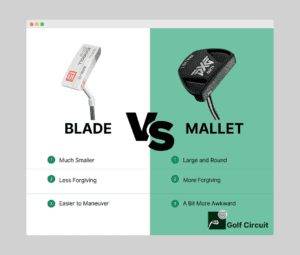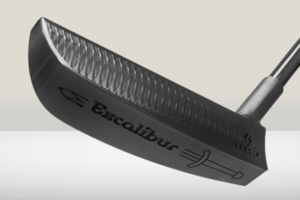People who play golf know how important it is to make putts on the greens. This is why picking the right putter shape is so important for your whole game. But there are different types of putters. How does the type of putter affect a golfer’s putting stroke? The different types of putters, how they can change your putting stroke, and what you should think about when picking the right putter design for your needs are all things that this piece will cover.
Understanding Putter Design
A putter is a club designed for use on the putting green, with a flat face and used primarily for short strokes. Putter design includes various components such as the head, shaft, grip, and alignment aid.
Types of Putter Designs
There are two main types of putter designs: blade putters and mallet putters.
Blade Putters
Blade putters have a traditional design with a thin, flat clubhead that is slightly curved. This design is ideal for golfers who have a consistent putting stroke and prefer a minimalist appearance. They are best for golfers who have a straight putting stroke as they provide a clear sightline to the target. Blade putters are often made of steel and have a smaller sweet spot.
Mallet Putters
The clubhead of a mallet putter is bigger and rounder, which is meant to make it more stable and forgiving. They work best for players whose strokes line up straight or in an arc. Most mallet putters are made of light materials like aluminium or graphite, and their sweet spot is bigger.
RELATED: What Makes Mach One Golf Balls Different From Other Golf
Comparison of the Two Designs and Their Impact on Putting Stroke

It is important to think about your putting stroke when picking between blade and mallet putters. If your putting stroke is straight, a blade putter is best for you. If your stroke is arcing or straight, a mallet putter is best for you.
Blade putters give you more feel and control, but you need to be steady and accurate with your putting stroke for them to work. There is more forgiveness and stability with mallet putters, but they can be harder to handle. Testing both types of putters is important to find the one that works best for your putting stroke.
How Blade Putters Affect Putting Stroke
Blade putters are easy to use because they have a simple form that lets you see the target clearly. This style works best for players whose putting stroke is consistent and accurate.
Why using a blade putter is a good idea
One of the best things about using a blade putter is that it gives you more control and feel. Blade putters are made to give golfers input so they can change their stroke to hit the ball more accurately. They also give you a clear view of the goal, which makes it easier to line up the clubhead with the ball.
Bad Things About Using a Blade Putter
The smaller sweet spot is one bad thing about using a blade putter. For blade putters to work, the putting stroke needs to be steady and accurate. A blade putter might not be the best choice for golfers who have trouble being consistent.
What do you do when you decide to get a new putter? Most likely, a lot of thoughts are running through your mind right now. There are a lot of beautiful putters out there, but you should also think about two very important factors that will affect your putting stroke: the shape and the weight.
How do form and weight change the way you putt?The technical side of ARGOLF is always a goal, which is why we split this into two parts: the first is about the shape of your putter, and the second is about how much it weighs.
The Design of a Putter Directly Affects its Aim
The explanation is complicated. According to GolfWRX, “97% of golfers think they are aiming at their target when in reality they are aiming somewhere else.” This largely depends on the putter design. How can beginner, amateur, or pro golfers fix this? The solution is simple: research and select the right weapon.
Many of you are familiar with several types of putters, blades, half mallets, and mallets. ARGOLF presents an explanation for their distinct differences. Each putter shape aids your swing. Research indicates that the roundness of a club head significantly impacts golfers’ aim perception. Today, we know that putters with rounder heads lead golfers to aim right. With a less round head, the golfer will aim left. This explanation is for right-handed golfers; left-handed golfers follow the opposite theory. Aim left with greater sight lines on your putter, which may be surprising. When positioned at the rear or front of a putter, they increase or decrease loft.
Not sure where to look or what putter to use? No issue. Grab an ARGOLF Collection blade putter to correct a right misalignment. We propose tasting the legendary Arthur. If you have left alignment issues, consider using a putter like the PENDRAGON.
Alignment is crucial for a reason. When a golfer isn’t adequately aiming to hit the ball on the planned line, last-second adjustments lead to stroke inconsistency. Players need fewer changes to hit the ball on line if they can better align themselves with their target.
While Design is Important, Weight is Even More Important
Are you a big golf fan? You may have noticed that the 4.25-inch hole is too small sometimes if you get there too quickly.How many strokes you need to score depends a lot on how fast the green is moving. To change how fast your ball goes, you need to change how you use your putter.
What makes your putter behave the way it does when you use it is its weight. People are naturally inclined to use their hands as “scales” to figure out how hard they need to work to lift different things. The putter is one of those things. Your brain needs to know the right things about your stroke, like how heavy the club is, how far away the goal is, and how fast you are hitting the ball.
From the article on the Moment of Inertia, you may already know that the weight of the putter’s head has a big effect on how well it works. A putter usually weighs 350 grammes, but you may need a putter with a lighter or higher weight. Let’s talk about how the way you carry your weight changes your putting stroke. There are two main types of putters used in golf, and each has a different weight balance:
TOE-DOWN BALANCED

One example is a putter with a toe that is down or heavy. These are generally in the classic blades collection. The famous EXCALIBUR blade putter from ARGOLF is a toe-heavy putter with a head that weighs 370 grammes and no alignment feature. This makes it a great choice for players who like to play by feel.
How does a putter that is heavy on the toe change your stroke? To begin, the force you’re putting on the club isn’t lining up with the centre of gravity of the clubhead.
It makes sense that the golfer should apply counter-torque to square the face at contact to counteract the torque that opens the club’s face. This kind of putter would work better for a player whose stroke is more arced.
FACE BALANCED

It is likely that you correctly guessed that a putter is considered to be face balanced if the face of the putter is oriented in an upward direction. The well-known MORDRED is arguably the example that best exemplifies this definition. The face of the club, which is characterised by its winged shape and stylish appearance, is oriented upward when it is lying on a level surface. For example, the head of this putter weighs 360 grammes, which is somewhat less than the head of the EXCALIBUR putter.
However, it has a low centre of gravity and boasts the highest Moment of Inertia among the mallets that are part of ARGOLF’s Collection. In what ways does a putter that is face balanced differ from one that is toe-down balanced? While the golfer is making the stroke, the force that is being applied by the golfer is in front of the centre of gravity, which results in a stable clubface.During the swing, there is no need to make any adjustments to the torque while using a putter that is face balanced.
Which of these resembles the putter that you now have in your possession? The putter’s shaft should be placed on a level surface, such as a table, and you should observe how the putter’s head comes to rest. This is a straightforward method. The putter that you own may require you to seek the advice of a fitting professional in order to determine whether or not the club is suited to your stroke in the appropriate manner.
Green Speed also controls your stroke
In addition to putter weight balancing, consider the speed of the green you play most often. As said, it’s part of appropriate fitting. How does green speed affect putter weight?
This has a mathematical explanation. We may need to swiftly review it. The equation for kinetic energy demonstrates that stroke velocity affects energy more than putter mass. What does it mean?
Basically, heavier putters result in slower swings. When habituated to quick greens, you may not notice. However, if you play on a slower green one morning, your ball will react differently.
Professional golfers stress that club head weight should match pace for accurate distance management. Some players benefit from a heavier head and slower/longer pendulum stroke. They believe the head’s weight does the task. Others want a lighter head for a shorter, faster stroke into the ball. Selecting the right head weight for your game improves distance control on the greens.
It’s scary to say the “Y” word, but don’t worry!
“How dare you talk about it on ARGOLF’s website?!!” you’ll say. But the truth is that you are safe from it if you have the right gear. You can improve your putting stroke by following the steps in this guide. In general, when you choose your next putter, you should think about everything, including the style, the weight, and even where you play the most.

I’m Donna Weiss, and I am the proud writer behind the captivating content you’ll find on golfneedy.com. As an avid golfer and passionate writer, I have combined my two greatest passions to bring you an incredible golfing experience. Through my articles, I aim to provide you with valuable insights, equipment reviews, and updates on the latest tournaments. Whether you’re a seasoned golfer or just starting out on this exciting journey, I am here to guide you and share my expertise. Together, let’s explore the fascinating world of golf, uncovering new techniques, and enhancing our skills. Join me on this thrilling adventure as we elevate our game and embark on an exciting golfing journey. Read More



